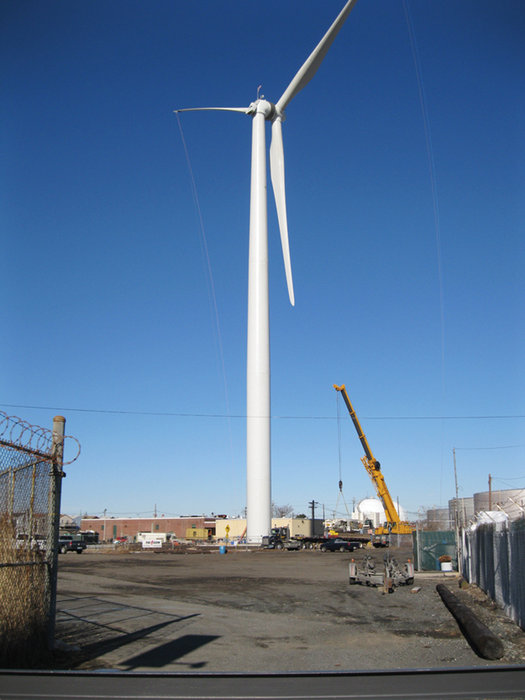No, it is not an alien spaceship that has landed near the Oak Street sewerage plant, although from over the tops of houses north of East Fifth Street and areas along Lennox Avenue, it might look like one – a towering, 262-foot tall, 70-ton stark white turbine, the first industrial windmill of its kind in Hudson County.
But instead of tearing up the landscape like some monster out of a Steven Spielberg movie, the new turbine will provide enough power to pump the city’s entire sewerage and still have enough to pump 40 percent of the city’s storm water. It will power the East Fifth Street pumping station that handles the stormwater needs for the center of the city and the east side.
The wind turbine has a power of 1.5 megawatts. The blades are 252 feet in diameter. Due to its height, the wind turbine project will be visible from Battery Park in Lower Manhattan and other places in the metropolitan area, according to the authority’s project engineers, Hatch Mott MacDonald of Milburn, N.J.
“This project with its cost savings will pay for itself.” — Steve Gallo
____________
The wind turbine was manufactured by Leitwind, an Austrian company, and supplied by its Colorado-based sister company, Leitner-Poma of America. This wind turbine is the first of its kind in the New York-Northern New Jersey metropolitan area and is expected to be fully operational by the end of March.
Because the turbine does not rely on a gear box to turn the electric generator, it will require less frequent maintenance, said Steve Gallo, executive director of the Bayonne Municipal Utilities Authority.
Instead, the turbine uses an innovative, patented generator with permanent magnets and an especially developed and optimized control system. Many components were manufactured in several locations in the United States. The rotor blades were made in North Dakota; the tower, in Tennessee; and all of the major high voltage equipment (transformers, switchgear, and control), was sourced from Colorado, Michigan, and New York. The concrete and steel used in the massive foundation were made by New Jersey-based companies.
Energy from the Leitwind Turbine will be used to power the Authority’s six 250-horsepower pumps at its Oak Street pumping station, and four150-horsepower pumps at its Fifth Street storm relief pumping station. The main Oak Street station is in continuous operation 24 hours a day.
“Our energy costs at our main pumping station at Oak Street represent the largest portion of our utility costs,” Gallo said.
Gallo said that on a normal dry day, the station pumps at the rate of 8 million gallons per day (MGD), sending the sanitary wastewater to the Passaic Valley Sewage Commissioners’ Regional Wastewater Treatment Facility in Newark. The greatest demand for electricity occurs during storms when the Oak Street station pumps the combined sanitary/storm wastewater at the rate of 40 MGD.
The project was funded in part by the American Recovery and Reinvestment Act, the economic growth legislation initiated by President Barack Obama.
Three years
The project has been in the works for more than three years. With a combination of $2.3 million in federal grants and about $800,000 in rebates from the New Jersey Board of Public Utilities, the project has the potential to cut operation costs in the city.
This is the best possible payback for the investments made in the project by the MUA. With cost overruns, the turbine will cost just under $6 million, Gallo said.
The balance of the cost, perhaps $1.8 million, is expected to be financed through the New Jersey Environmental Infrastructure Trust, which offers 20-year loans at highly competitive rates.
“This project with its cost savings will pay for itself,” Gallo said.
